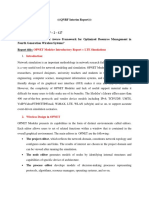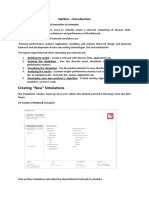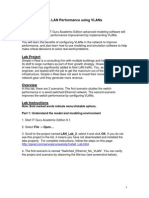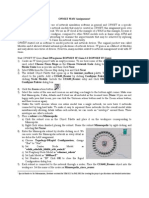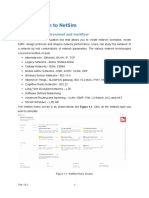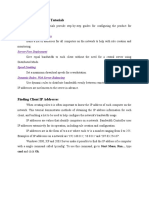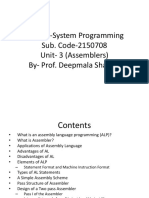Modelling Network
Uploaded by
thawdarModelling Network
Uploaded by
thawdarUsing FLOWMASTER to Model Networks
Page 1 of 23
Using Flowmaster to Model Networks
When modeling a network you use components from Flowmasters' wide range of components. Each Flowmaster component is mathmatical representation of an engineering component. Selected components are connected together via nodes to form a network which forms the actual computer model of the flow system. Once the model has been set up, and the general conditions of the system have been defined the simulation can be run and the results interpreted. You should always begin by producing a simple model of the conceptual design and progress in stages to a precise detailed model of the whole system. When using Flowmaster to design networks, you should always work through the following steps: 1. Consider the real system 2. Decide on the degree at which to model the system 3. Assemble the necessary data 4. Produce a Flowmaster network 5. Enter the specific data for the components in the network 6. Set up the general conditions for the network on the Simulation Data form 7. Run the simulation 8. Interpret the results 9. Repeat the procedure, refining and modifying the network. When using Flowmaster to model networks, there are certain rules that you should understand before proceeding. To find out what they are, click on the link below.
Modelling Networks - Rules
When modelling Incompressible and Compressible networks, there are a number of rules that you should understand before proceeding. To find out what they are, click on
file://C:\Documents and Settings\Maung Tint\Local Settings\Temp\~hhF3AE.htm
8/12/2010
Using FLOWMASTER to Model Networks
Page 2 of 23
one of the links below. The section expands to show you the relevant details: Find out about rules when modelling networks Incompressible (Non-Hydraulic Power) Click the tab to see the rules when modelling non-hydraulic power networks. Compressible Flow Click the tab to see the rules when modelling Compressible Flow networks. Hydraulic Power Click the tab to see the rules when modelling Hydraulic Power networks. The aim of these rules are to outline the problems that are associated with fluid flow networks and to guide you through the modelling process.
Networks - Creating Networks
To create a new network, proceed as follows: 1. Click on the 'Networks' tab to display the 'Networks' pane. 2. Next, click on the project you want to add the network to. This action exposes the 'New Network' button shown below:
3. Click the button. The network is added to the list as 'New Network Name' and is highlighted. Also, its properties are displayed in the lower pane (see below) and the 'Network Drawing' window opens. 4. Enter the name of the network. To see how you create a new network, move the mouse over the image below:
file://C:\Documents and Settings\Maung Tint\Local Settings\Temp\~hhF3AE.htm
8/12/2010
Using FLOWMASTER to Model Networks
Page 3 of 23
5. To give the network a description, click in the adjacent cell to expose a button. Click the button to display the 'Description' dialog. 6. Enter the description and then click OK. 7. The next step is to add the required components to complete the network. To see how you do this, click on the 'Related Topics' link. Related Topics
Copying and Moving Networks
Copying Networks
There are two copy options available for copying networks; namely: 1. Child - with this option, the copied network is 'attached' to the parent network, one level down as shown below. 2. Sibling - with this option, the copied network is displayed at the same level as the parent network, as shown below.
To make a copy of a network, proceed as follows:
file://C:\Documents and Settings\Maung Tint\Local Settings\Temp\~hhF3AE.htm
8/12/2010
Using FLOWMASTER to Model Networks
Page 4 of 23
1. Click the 'Networks' tab to see all your networks. 2. Right-click on the parent network and select the 'Copy' option. The 'Network Copy Option' dialog is displayed:
3. Select the required option to copy the network. 4. To rename the network, go to the lower pane and enter the new name in the cell next to 'Name'.
Moving Networks
This option allows you to 'drag-and-drop' networks between diferent projects. This can useful for users that have access to multiple projects, in that they can drag a network from one project to another. For projects that have been 'shared-out' to other users, it is only possible for a user to move a network from a project for which he has full access to. What about the hierachy structure If you have a network that has associated child networks (see above), then when you move the 'master' network, the hierachy structure is maintained. Also, the results are retained for each network. Pre-requisites In order to move a network, say from 'Project_1' to 'Project_2', then you have to be assigned 'Network Creator' status for the project you are logged-on to. For more details about user access, click-on the following link: Setting-up User Accounts How do I move a network? Basically, you left-click on the required network and drag it to its new location. To see how you do this. move the mouse over the image below:
file://C:\Documents and Settings\Maung Tint\Local Settings\Temp\~hhF3AE.htm
8/12/2010
Using FLOWMASTER to Model Networks
Page 5 of 23
Networks - Deleting a Network
You can only delete a network, if you (i) own the project to which it belongs or (ii) have administrator privileges. To delete a project, proceed as follows: 1. Click on the 'Networks tab. Next, click on the 'top-level' administration entry to display all the associated projects. 2. Next, click on the required to display all its associated networks. 3. Click on the network you want to delete. The following confirmation dialog is displayed:
4. Click the 'Yes' button to display the 'Confirm Extended Deletion' dialog shown below:
The Network Drawing Window
The 'Network Drawing' window comprises two panes both of which are discussed below. View Window?
The Left Pane
file://C:\Documents and Settings\Maung Tint\Local Settings\Temp\~hhF3AE.htm
8/12/2010
Using FLOWMASTER to Model Networks
Page 6 of 23
This is the Network Drawing pane. It is used to create new networks and display existing networks. To build a network, you (i) click the 'Catalogues' tab, (ii) open the 'Components' catalogue, (iii) open a sub-catalogue (e.g. Bends) and drag a component into the drawing pane.
The Network Views Pane
This is a multifunction pane that comprises four tabbed forms. As you click a tab, the view in this pane changes accordingly. The forms are discussed as follows. The Data Form This is the default form and it comprises two panes. The top pane is used to collect components and nodes. When you select a components and node, its data form is displayed in the lower pane. The form is also used to display results for selected components and nodes. To the left of the data form, is a series of buttons. To see what they do, move the mouse over a button to display a tooltip.
The Var. Param Form This form allows you to create Variable Parameters, which are a way of inputting data in a simplified form. The parameters can then be applied to other components of the same type. Entering data in this way can be of great help when performing parametric studies. The parameters themselves MUST be entered in [ ] brackets. For example, if you wanted to specify the Pipe Diameter, you would enter is as follows: [pd1] If you were entering the Orifice Diameter, then you would input the diameter as: [od1] You can also enter data as an expression. For example: [k]/2 Where k is the loss coefficient.
file://C:\Documents and Settings\Maung Tint\Local Settings\Temp\~hhF3AE.htm
8/12/2010
Using FLOWMASTER to Model Networks
Page 7 of 23
In addition, you can also access an external database and retieve values from stored procedures. These values can then be applied to the relevant components. The Sim. Data Form This form comprises two panes. The top pane is used to set the data for the required simulation, while the lower pane is used to:
Initiate or abort the simulation Disable feedback See simulation run-time messages Set-up dynamic colouration.
The Result Sets/Audit Form This form shows a list of results sets for simulations that have been run. Each result set is shown in the order that the simulation was performed. In addition, the list also shows:
The type of simulation that was performed The description of each simulation The date that each simulation was run Whether a particular simulation was successful or not.
To look at the results for a particular simulation, you first have to open a network. Having done this, proceed as follows: 1. Double-click on the required result set. When you do this, the following actions occur: a. The 'Data' form is displayed with the components loaded into the 'Collection List', and b. The mode is set to 'Results' and the results for the first component in the list are displayed in the lower pane. To view node results, continue as follows: 2. With the 'Data' form displayed, click the Filter dialog. button to open the Component Result
3. Click the 'Nodes' button to load the nodes into the collection list. You can now select a feature from the list and then use the various options to view the results. From this form, you can also:
file://C:\Documents and Settings\Maung Tint\Local Settings\Temp\~hhF3AE.htm
8/12/2010
Using FLOWMASTER to Model Networks
Page 8 of 23
1. Delete a results set. 2. Amend the description for a particular results set. 3. Look at Errors and Warnings reports.
Building a Network
You build a network by placing components in the 'Network Drawing' window. In Flowmaster, components are grouped in the 'Components Catalogue'.
The following steps assume that you have already created a network and are adding components to it. If you have not already created one, then click on the following link: Create a New Network? To build a Network proceed as follows: 1. With the 'Network Drawing' window open, click on the 'Catalogues' tab to see all the available catalogues. 2. Next, open the 'Components' entry to see all the available component catalogues. 3. Next, open the required one (e.g. Bends) to see all the available components. 4. As you move the mouse over a component, its associated symbol is displayed. To add the component, left-click on it and drag it into the drawing window.
If you want to add a number of components of the same type, right-click on the required one and select the 'Copy' option. Move the cursor to the required position and click the left mouse button to display the copy. 5. To add other components, open another component catalogue and add the components as described in Steps 3 and 4. 6. To see how you place components in the 'Network Drawing' window, move the mouse over the image below:
7. Having placed the components, the next step is to connect them together. To see how you do this, click on the 'Related Topics' link.
file://C:\Documents and Settings\Maung Tint\Local Settings\Temp\~hhF3AE.htm
8/12/2010
Using FLOWMASTER to Model Networks
Page 9 of 23
Related Topics
Adding Components
There are two ways that you can add components. Both are explained as follows. Adding components from the network drawing window? To do this proceed as follows: 1. Right-click on the component that you want to add and select the 'Copy' option. 2. Move the cursor to the new position and then right-click to place the component. 3. To add other components of the same type, repeat Steps 1 and 2. Adding components from a catalogue? To do this proceed as follows: 1. To add components, click the 'Catalogues' tab. Next, click-on the + sign next to the Flowmaster Supplied Components entry to see all the available component catalogues. 2. Next, click on the + sign next to the required catalogue to see all the available components. 3. As you move the mouse over a component, its associated symbol is displayed. To add the component, left-click on it and drag it into the drawing window. To see an example, move the mouse over the image below:
If you are adding a number of components of the same type, say Bends, then you can use the Pallete window to add components. To find out about the Pallete, click on the link below: Using the Pallete Window
file://C:\Documents and Settings\Maung Tint\Local Settings\Temp\~hhF3AE.htm
8/12/2010
Using FLOWMASTER to Model Networks
Page 10 of 23
Aligning Components
The Align facility allows you to align components and nodes. There are trwo options available: 1. Align horizontally, and 2. Align verically.
Align Components Horizontally
To do this proceed as follows: 1. Using the mouse draw a box around the components that you want to align. 2. Next, click the button to align them.
You should only use this facility when the components are more or less in a straight line. If you attempt to align components where one is above another one as shown below:
Then this happens:
Align Components Verically
To do this proceed as follows: 1. Using the mouse draw a box around the components that you want to align.
file://C:\Documents and Settings\Maung Tint\Local Settings\Temp\~hhF3AE.htm
8/12/2010
Using FLOWMASTER to Model Networks
Page 11 of 23
2. Next, click the
button to align them.
Like the 'Align Horizontally' option, you should only use this facility when the components are more or less alligned verically. If you attempt to align components that are aligned in the manner shown below:
Then this happens:
Using the Pallete Window
The Pallete window is a 'dockable' window that can be used to store components. It appears as a tab, at the left of the main window and automatically expands when you click on the tab. For example:
file://C:\Documents and Settings\Maung Tint\Local Settings\Temp\~hhF3AE.htm
8/12/2010
Using FLOWMASTER to Model Networks
Page 12 of 23
The function of the Pallete is to store components. If you click on a catalogue, say Bends, then all the Bends are displayed in the Pallete window. When you click the tab to see all the components, then the name changes on the tab accordingly. For example:
file://C:\Documents and Settings\Maung Tint\Local Settings\Temp\~hhF3AE.htm
8/12/2010
Using FLOWMASTER to Model Networks
Page 13 of 23
One major use of the pallete, is that you can quickly access all components comprising the selected catalogue. Also, the pallete can be 'floated' anywhere within the 'Flowmaster' window. This enables you to quickly access the components you require.
Connecting Components
To do this proceed as follows: 1. Point to the first connection point. The cursor changes to:
Also a label is displayed showing the connection type. 2. Holding the left button down, drag the mouse to draw a line to the next connection point. As you do this, the following dialog is displayed asking you to select the circuit type:
Select the circuit type and then click OK. 3. Release the left mouse button. Depending on the connection type(s), a node point is automatically inserted. To see a movie on how you connect components, move the mouse over the image below:
file://C:\Documents and Settings\Maung Tint\Local Settings\Temp\~hhF3AE.htm
8/12/2010
Using FLOWMASTER to Model Networks
Page 14 of 23
4. Having built the network, the next step is to set the component Data. Related Topics
Connections and Their Meanings
The three figures shown below demonstrate the placement of connections on Flowmaster symbols. The figures are presented in the form of a slide show. Clicking the 'Next' button displays the next figure in the sequence, while clicking the 'Back' button displays the previous figure. The following points relate to the placement of connections: 1. All connections are colour and shape coded as an aid to identification (see Figure 1). 2. A maximum of 60 connection points (e.g. ports) are allowed per symbol (see Figure 2). 3. 15 connection points are allowed per edge of each symbol, starting from position 0 (see Figure 2). 4. Fluid, force and solid connections are located at the centre of each symbol to aid alignment (see Figure 3).
file://C:\Documents and Settings\Maung Tint\Local Settings\Temp\~hhF3AE.htm
8/12/2010
Using FLOWMASTER to Model Networks
Page 15 of 23
<<Back
Next>>
Figure 2 shows how connections can be placed around the component symbol. In practice though, you would place the symbols as shown in Figure 3, which shows the symbol for an AC Evaporator.
Changing the Connection Type
The conection (e.g. link) between components can be one of the following: 1. Straight, or 2. Orthogonal. To change the connection type, proceed as follows: 1. Depending on how the connection is set, right-click on the required connection and
file://C:\Documents and Settings\Maung Tint\Local Settings\Temp\~hhF3AE.htm
8/12/2010
Using FLOWMASTER to Model Networks
Page 16 of 23
select one of the following options: a. Straight b. Orthogonal. 2. The line changes accordingly. To see a movie on how you change the connection, move the mouse over the image below:
Copying Components
Copying a single component To copy a single component proceed as follows: 1. Left-click on the required component and select the 'Copy' option. 2. Move the cursor to the required position and left-click to place the component. 3. Right-click and select Idle mode to escape from the copy mode.
When you copy a component, any associated text is also copied.
Copying a group of components To copy a group of components proceed as follows: 1. Using the mouse, draw a box around the components you want to copy. The group is highlighted in red. 2. Left-click on the group and select the 'Copy' option. 3. Move the cursor to the required position and left-click to place the group. 4. Right-click and select Idle mode to escape from the copy mode.
file://C:\Documents and Settings\Maung Tint\Local Settings\Temp\~hhF3AE.htm
8/12/2010
Using FLOWMASTER to Model Networks
Page 17 of 23
When you copy a group of components, any associated component text is also copied.
Deleting Components and Nodes
Deleting Components To delete a component, proceed as follows: 1. Click-on the component you want to delete. A red box is shown around the component. 2. Next, press the 'Delete' key. A confirmation dialog is displayed. 3. Click 'Yes' to continue. The dialog shown below is displayed:
4. If you choose the first option, then: a. A copy is made and the copy is appended to the original network in the 'Networks' pane. b. The copy is opened so that you can now delete the component and continue. 5. If you choose the second option, then: a. The results are deleted. b. The network remains in place, minus the deleted component.
file://C:\Documents and Settings\Maung Tint\Local Settings\Temp\~hhF3AE.htm
8/12/2010
Using FLOWMASTER to Model Networks
Page 18 of 23
Any text associated wth the component is also highlighted and will be deleted.
Deleting Nodes When you delete nodes, the process is the same as that for components.
Mirroring Components
You use the Mirror in X-axis and the Mirror in Y-axis buttons to mirror (flip) components in the X or Y plane. The mode of the controls vary, depending on the actions you want to perform. For example: Mirror a Single Component in the X Plane To do this proceed as follows: 1. Select the required component. 2. Click the button to flip the component. 3. Alternatively, select the component and then press the 'X' key to flip it. Mirror Multiple Components in the X Plane Use this mode if you want mirror more than one component. To do this proceed as follows: 1. Double-click the button to set the Mirror in X-axis mode. As you move the cursor back to the Network window, the cursor changes to:
2. Left-click on the required component to flip it. 3. To exit from the 'Mirror in X-axis' mode, press the 'Esc' key. Mirror a Single Component in the Y plane? To do this proceed as follows:
file://C:\Documents and Settings\Maung Tint\Local Settings\Temp\~hhF3AE.htm
8/12/2010
Using FLOWMASTER to Model Networks
Page 19 of 23
1. Select the required component. 2. Click the button to flip the component. 3. Alternatively, select the component and then press the 'Y' key to flip it. Mirror Multiple Components in the Y Plane Use this mode if you want mirror more than one component. To do this proceed as follows: 1. Double-click the button to set the Mirror in Y-axis mode. As you move the cursor back to the Network window, the cursor changes to:
2. Left-click on the required component to flip it. 3. To exit from the 'Mirror in Y-axis' mode, press the 'Esc' key.
Replacing Components
You can replace components directly from the 'Network Drawing' window. The process comprises the following steps: 1. Specifying the replacement method. 2. Specifying the new compatible component type. 3. Specifying whether you want to: a. Keep the existing results and create a copy of the network, or: b. Delete the results and modify the network. 4. Perform the changes and reload the network. To replace a component, proceed as follows: 1. With the 'Network Drawing' window open, click the button. The 'Component Replacement' dialog is displayed. To see the dialog, click-on the link below: View Dialog? 2. Continue as shown below:
file://C:\Documents and Settings\Maung Tint\Local Settings\Temp\~hhF3AE.htm
8/12/2010
Using FLOWMASTER to Model Networks
Page 20 of 23
To Determine the replacement method Specify the compatible component type
Do this 1. Click the required radio button. 2. Next, click the 'Proceed' button. 1. Click the 'Proceed' button. The 'Select Replacement Component' dialog is displayed. The dialog functions in the same way as 'Selection from Catalogue' dialog, which is used to search the database. To see how you can search for components, click on the following link: Searching the Database 2. Follow the steps in the 'linked-to' topic. Upon selecting the new component, its name is displayed. 3. Next, click the proceed button.
Determine whether or not to keep the results
1. To keep the results and create a copy of the network, click the associated radio button, or: 2. To delete the results and continue to modify the network, click the associated radio button. 3. Next, click the 'Proceed' button.
Performing the changes.
Depending on the actions taken in Step 3, then: 1. If you chose the first option in Step 3, then the change is made and: a. The original network is closed. b. A copy is made and the copy is appended to the original network in the 'Networks' pane. c. The copy is opened with the new component(s) in place. 2. If you chose the second option in Step 3, then: a. The change is made b. The network is closed and then reopened with the new component(s) in place.
file://C:\Documents and Settings\Maung Tint\Local Settings\Temp\~hhF3AE.htm
8/12/2010
Using FLOWMASTER to Model Networks
Page 21 of 23
Rotating Components
You use the Rotate button from the Commands toolbar to rotate components. The mode of the control varies, depending on the actions you want to perform. For example: Rotate a Single Component To do this proceed as follows: 1. Select the required component. 2. Click the button to rotate the component 90o. Each successive click rotates the component a further 90o. 3. Alternatively, select the component and then press the 'R' key to rotate it. Rotate Multiple Components Use this mode if you want to rotate more than one component. To do this proceed as follows: 1. Double-click the button to set the Rotate mode. As you move the cursor back to the Network window, the cursor changes to:
2. Left-click on the component you want to rotate. Each click rotates the component 90o. 3. To exit from the 'Rotate' mode, press the 'Esc' key. Rotate a Group of Components To do this proceed as follows: 1. Using the mouse, draw a box around the components you want to rotate. The components are outlined in red. 2. Next, click the button to rotate them.
file://C:\Documents and Settings\Maung Tint\Local Settings\Temp\~hhF3AE.htm
8/12/2010
Using FLOWMASTER to Model Networks
Page 22 of 23
Flowmaster Pipe Symbols
Of the four basic pipe components available, each of them can be modelled in a number of ways. The following table shows the pipe symbol for each type of pipe that can be modelled. Table 1: Available Pipe Models and Corresponding Symbols Type of Pipe Cylindrical Pipe Available Models Bubbly (Variable Wave Speed Model) Corresponding Symbol
Compliant
Elastic
Rigid
Hexagonal Pipe
Bubbly (Variable Wave Speed Model)
Compliant
Elastic
Rigid
Prismatic Pipe
Bubbly (Variable Wave Speed Model)
Compliant
file://C:\Documents and Settings\Maung Tint\Local Settings\Temp\~hhF3AE.htm
8/12/2010
Using FLOWMASTER to Model Networks
Page 23 of 23
Elastic
Rigid
Rectangular Pipe
Bubbly (Variable Wave Speed Model)
Compliant
Elastic
Rigid
Cylindrical Pipe
Gas (Compressible Flow only)
Flexible Pipes
Pipes can be flexible or straight. To see how you can create a flexible pipe, proceed as follows: 1. Right-click on a pipe and select the 'Pipe Style - Flexible' option. 2. Next, click-on the end of the pipe and then drag the mouse to shape the pipe. To see an example, move the mouse over the image below.
file://C:\Documents and Settings\Maung Tint\Local Settings\Temp\~hhF3AE.htm
8/12/2010
You might also like
- Catia Tutorial Electrical Harness Installation PDFNo ratings yetCatia Tutorial Electrical Harness Installation PDF92 pages
- Opnet Labs: Due by Nov 17 2003 Before Class Start and Please Provide Cover Page With Your Names On It. Thanks!No ratings yetOpnet Labs: Due by Nov 17 2003 Before Class Start and Please Provide Cover Page With Your Names On It. Thanks!17 pages
- OPNET Modeler - Introduction LTE SimulationNo ratings yetOPNET Modeler - Introduction LTE Simulation16 pages
- Lab 1 - Getting Started With Opnet Modeler100% (1)Lab 1 - Getting Started With Opnet Modeler18 pages
- CSC305-Lab1 (1) .PDF Data Communications and NetworksNo ratings yetCSC305-Lab1 (1) .PDF Data Communications and Networks24 pages
- Lab 1, Getting Started With Opnet Modeler Creating A New ProjectNo ratings yetLab 1, Getting Started With Opnet Modeler Creating A New Project18 pages
- LABSHEET-9 Introduction To Network Simulator (OPNET)No ratings yetLABSHEET-9 Introduction To Network Simulator (OPNET)18 pages
- Cytoscape Hands-On Tutorial For SDCSB Cytoscape Workshop 12/4/2012No ratings yetCytoscape Hands-On Tutorial For SDCSB Cytoscape Workshop 12/4/201226 pages
- A2 Opnet CSD340 Network Design Performance 2015 Your-First-Name Your-Last-NameNo ratings yetA2 Opnet CSD340 Network Design Performance 2015 Your-First-Name Your-Last-Name8 pages
- ADS Tutorial: A Beginners Tutorial: Modes of OperationNo ratings yetADS Tutorial: A Beginners Tutorial: Modes of Operation22 pages
- Getting Started Tutorial: What You'll Learn in This TutorialNo ratings yetGetting Started Tutorial: What You'll Learn in This Tutorial22 pages
- Lab Manual For OPNET Training: Using This BookNo ratings yetLab Manual For OPNET Training: Using This Book51 pages
- Lab 1: Evaluating Internet Connection Choices For A Small Home PC Network Due - Feb 02, 5:30 PM Points - 20No ratings yetLab 1: Evaluating Internet Connection Choices For A Small Home PC Network Due - Feb 02, 5:30 PM Points - 2013 pages
- ECCE221 - Lab0 - Installation and Introduction To MULTISIMNo ratings yetECCE221 - Lab0 - Installation and Introduction To MULTISIM20 pages
- C# Database Connection Tutorial With Example100% (3)C# Database Connection Tutorial With Example35 pages
- Blender 4.3 Guide for All: Mastering 3D Design and AnimationFrom EverandBlender 4.3 Guide for All: Mastering 3D Design and AnimationNo ratings yet
- H2Safe LLC Has A Patent On Technology For Safer StorageNo ratings yetH2Safe LLC Has A Patent On Technology For Safer Storage1 page
- LNG Fire Resistance of Concrete StructureNo ratings yetLNG Fire Resistance of Concrete Structure7 pages
- Engineering Layout of Fuel Tanks in A Tank Farm - J of LP100% (1)Engineering Layout of Fuel Tanks in A Tank Farm - J of LP7 pages
- Understand Heat Flux Limitations On Reboiler Design PDFNo ratings yetUnderstand Heat Flux Limitations On Reboiler Design PDF10 pages
- Assessment of Domino Efect - QRA ApproachNo ratings yetAssessment of Domino Efect - QRA Approach6 pages
- Anaerobic Digestion in EnvironmntalEngineeringNo ratings yetAnaerobic Digestion in EnvironmntalEngineering278 pages
- User Manual - H.264 DVR - 20100301 - (5479KB)No ratings yetUser Manual - H.264 DVR - 20100301 - (5479KB)65 pages
- The Solution For Campus Security Brochure PDFNo ratings yetThe Solution For Campus Security Brochure PDF12 pages
- Dissertation Juridique Le President de La Republique100% (1)Dissertation Juridique Le President de La Republique5 pages
- How To Reset Forgotten VMware ESXi Root Password With Ubuntu Live CD PDFNo ratings yetHow To Reset Forgotten VMware ESXi Root Password With Ubuntu Live CD PDF5 pages
- NCA March 2023 Requirements - Exigences Pour Les Examens Du CNE en MarsNo ratings yetNCA March 2023 Requirements - Exigences Pour Les Examens Du CNE en Mars4 pages
- 8-Bit Microcontroller With 12K Bytes Flash AT89S53: FeaturesNo ratings yet8-Bit Microcontroller With 12K Bytes Flash AT89S53: Features32 pages
- Ojukwu Somkene: Advanced Software EngineeringNo ratings yetOjukwu Somkene: Advanced Software Engineering2 pages
- Subject-System Programming Sub. Code-2150708 Unit-3 (Assemblers) by - Prof. Deepmala SharmaNo ratings yetSubject-System Programming Sub. Code-2150708 Unit-3 (Assemblers) by - Prof. Deepmala Sharma52 pages
- Full Stack Developer Course With Placement SupportNo ratings yetFull Stack Developer Course With Placement Support3 pages
- IILM UNIVERSITY - MAKEUP-2024-25 UpdatedNo ratings yetIILM UNIVERSITY - MAKEUP-2024-25 Updated12 pages
- How-To Troubleshoot Authentication Errors Using View AUTHENTICATION_ERROR_DETAILS From HANA 2.0 SPS08No ratings yetHow-To Troubleshoot Authentication Errors Using View AUTHENTICATION_ERROR_DETAILS From HANA 2.0 SPS082 pages
- Vienna Ensemble PRO 5 Manual English v2.81No ratings yetVienna Ensemble PRO 5 Manual English v2.81103 pages
- Stand-Alone Access Control Dh16a-10dt w6.5.09No ratings yetStand-Alone Access Control Dh16a-10dt w6.5.095 pages
- Catia Tutorial Electrical Harness Installation PDFCatia Tutorial Electrical Harness Installation PDF
- Opnet Labs: Due by Nov 17 2003 Before Class Start and Please Provide Cover Page With Your Names On It. Thanks!Opnet Labs: Due by Nov 17 2003 Before Class Start and Please Provide Cover Page With Your Names On It. Thanks!
- CSC305-Lab1 (1) .PDF Data Communications and NetworksCSC305-Lab1 (1) .PDF Data Communications and Networks
- Lab 1, Getting Started With Opnet Modeler Creating A New ProjectLab 1, Getting Started With Opnet Modeler Creating A New Project
- LABSHEET-9 Introduction To Network Simulator (OPNET)LABSHEET-9 Introduction To Network Simulator (OPNET)
- Cytoscape Hands-On Tutorial For SDCSB Cytoscape Workshop 12/4/2012Cytoscape Hands-On Tutorial For SDCSB Cytoscape Workshop 12/4/2012
- A2 Opnet CSD340 Network Design Performance 2015 Your-First-Name Your-Last-NameA2 Opnet CSD340 Network Design Performance 2015 Your-First-Name Your-Last-Name
- ADS Tutorial: A Beginners Tutorial: Modes of OperationADS Tutorial: A Beginners Tutorial: Modes of Operation
- Getting Started Tutorial: What You'll Learn in This TutorialGetting Started Tutorial: What You'll Learn in This Tutorial
- Lab 1: Evaluating Internet Connection Choices For A Small Home PC Network Due - Feb 02, 5:30 PM Points - 20Lab 1: Evaluating Internet Connection Choices For A Small Home PC Network Due - Feb 02, 5:30 PM Points - 20
- ECCE221 - Lab0 - Installation and Introduction To MULTISIMECCE221 - Lab0 - Installation and Introduction To MULTISIM
- Blender 4.3 Guide for All: Mastering 3D Design and AnimationFrom EverandBlender 4.3 Guide for All: Mastering 3D Design and Animation
- The Personal Finance Application How to Save MoneyFrom EverandThe Personal Finance Application How to Save Money
- Human VS computer: World wide education (WWE)From EverandHuman VS computer: World wide education (WWE)
- Group Policy: Fundamentals, Security, and the Managed DesktopFrom EverandGroup Policy: Fundamentals, Security, and the Managed Desktop
- H2Safe LLC Has A Patent On Technology For Safer StorageH2Safe LLC Has A Patent On Technology For Safer Storage
- Engineering Layout of Fuel Tanks in A Tank Farm - J of LPEngineering Layout of Fuel Tanks in A Tank Farm - J of LP
- Understand Heat Flux Limitations On Reboiler Design PDFUnderstand Heat Flux Limitations On Reboiler Design PDF
- Dissertation Juridique Le President de La RepubliqueDissertation Juridique Le President de La Republique
- How To Reset Forgotten VMware ESXi Root Password With Ubuntu Live CD PDFHow To Reset Forgotten VMware ESXi Root Password With Ubuntu Live CD PDF
- NCA March 2023 Requirements - Exigences Pour Les Examens Du CNE en MarsNCA March 2023 Requirements - Exigences Pour Les Examens Du CNE en Mars
- 8-Bit Microcontroller With 12K Bytes Flash AT89S53: Features8-Bit Microcontroller With 12K Bytes Flash AT89S53: Features
- Subject-System Programming Sub. Code-2150708 Unit-3 (Assemblers) by - Prof. Deepmala SharmaSubject-System Programming Sub. Code-2150708 Unit-3 (Assemblers) by - Prof. Deepmala Sharma
- Full Stack Developer Course With Placement SupportFull Stack Developer Course With Placement Support
- How-To Troubleshoot Authentication Errors Using View AUTHENTICATION_ERROR_DETAILS From HANA 2.0 SPS08How-To Troubleshoot Authentication Errors Using View AUTHENTICATION_ERROR_DETAILS From HANA 2.0 SPS08







